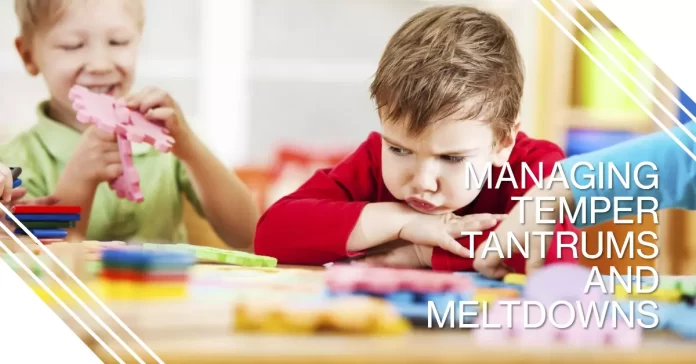Temper tantrums and meltdowns are common behavioral challenges that many children experience. This article aims to provide parents and caregivers with successful strategies and tips for handling these situations. You can navigate temper tantrums and meltdowns in a way that promotes emotional regulation, fosters healthy communication, and strengthens the parent-child relationship by understanding the underlying causes and implementing appropriate techniques.
Handling Temper Tantrums and Meltdowns in Children: Effective Strategies and Tips
Set clear and consistent boundaries
Establishing clear expectations and limits, such as stating rules about behavior and consequences, helps children understand what is acceptable and reduces the likelihood of tantrums.Stay calm and composed
When dealing with a tantrum, always remember to take deep breaths, maintain a composed demeanor, and speak in a tone. It helps create a calm environment and sets an example for children to learn how to regulate their own emotions.Use positive reinforcement
Praise and acknowledge your child’s good behavior or efforts to express themselves calmly. It encourages positive choices and reinforces alternative ways to handle frustrations, reducing the frequency of tantrums.Practice active listening
Give your child your full attention, maintain eye contact, and listen attentively to their concerns or frustrations. Validating their feelings and providing a safe space for expression can help diffuse tantrums and prevent them from escalating.Offer choices
Provide limited choices within reasonable boundaries to give children a sense of control. For example, offer options for activities or snacks, allowing them to make decisions and reducing frustration that can lead to tantrums.Teach and practice emotional regulation
Help children identify and manage their emotions through age-appropriate techniques. Teach them deep breathing exercises or encourage them to count to ten, providing tools to calm themselves down and navigate between tantrums.Use distraction and redirection
When you notice tantrum signs, divert your child’s attention to a different activity, toy, or topic. This redirection can shift their focus from the triggering situation and help defuse the tantrum.Implement a consistent routine
Establishing predictable daily routines, such as regular meal times and bedtime rituals, helps children feel secure and reduces anxiety. Predictability minimizes potential triggers for tantrums.Model appropriate behavior
Children learn by observing, so be a positive role model for emotional regulation. Demonstrate healthy ways to handle frustration and stress, using problem-solving techniques and expressing emotions calmly to teach children effective coping strategies.Seek support and prioritize self-care
To share experiences and seek guidance, reach out to a trusted support network of friends, family, or parenting groups. Additionally, prioritize self-care to preserve your emotional well-being, enabling you to provide better support to your child during challenging moments.
Conclusion
With the right approach, parents and children can transform temper tantrums and meltdowns from overwhelming experiences into opportunities for growth and learning. You can create a supportive and nurturing environment that helps children develop essential emotional regulation skills. Consistency, patience, and empathy are vital when handling these challenging moments. Fostering a positive and harmonious atmosphere within your family with practice and understanding, you can effectively navigate temper tantrums and meltdowns.
Frequently Asked Questions (FAQs)
Why do children have temper tantrums?
Temper tantrums can occur for various reasons, including frustration, fatigue, hunger, or difficulty expressing emotions.
At what age do temper tantrums typically occur?
Temper tantrums are most common in toddlers and preschool-aged children, usually between the ages of 1 and 4.
How can I prevent temper tantrums?
While tantrums are a normal part of child development, you can minimize their frequency by maintaining a consistent routine, providing clear expectations, and addressing your child’s needs promptly.
What should I do during a temper tantrum?
Stay calm, ensure your child’s safety, and offer comfort. Avoid giving in to demands, but provide reassurance and wait until the tantrum subsides before addressing the issue.
Should I consider seeking professional help for my child’s tantrums?
If tantrums are excessive, significantly impacting daily life, or persisting beyond the typical age range, it may be beneficial to consult a pediatrician or child development specialist for further evaluation and guidance.










